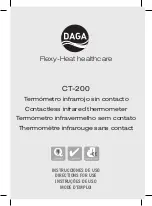
•
Open, shorted, or damaged sensor or lead wires.
In the case of resis-
tance sensors check the resistance across the sensor using a hand-held
DMM. Also check the resistance between common pairs of leads. Check
to make sure there is no conductivity between any of the leads and the
probe sheath. Use a good-quality sensor to avoid errors caused by drift,
hysteresis, or insulation leakage. In the case of thermocouples, use a
hand-held DMM to check its voltage.
•
Improper setting for three or four-wire probe.
When using the 2562 or
2564 scanner modules you need to make sure the correct wiring type is
selected (read carefully Section 9.3.1 or 11.3.1). Selecting three-wire in-
put while using four-wire probes may cause errors of 0.01 to 0.1
Ω
. Se-
lecting four-wire input while using three-wire probes will result in erratic
or out-of-range readings.
•
Electrical interference.
Intense radio-frequency radiation near the 1560
or probes can induce noise into the measurement circuits resulting in er-
ratic readings. The 1560 is intended to operate in a laboratory environ-
ment with limited radio-frequency noise. If interference seems to be a
problem you might try eliminating the source of interference or moving
the 1560 to a different location. A well-grounded, shielded cable should
be used for the probe leads.
•
Stem conduction error.
The problem may be that the actual temperature
of the sensor is not what you expect. This is often the result of stem con-
duction where heat flowing through the stem of the probe to ambient af-
fects the temperature of the probe. It is very important that immersion
probes be inserted to an adequately depth into the material being mea-
sured. Measuring temperature using a surface sensor can be especially
difficult as the sensor is directly exposed to ambient.
16.3
Communication Difficulties
You are having trouble establishing communications between the 1560 and a
remote computer using either the base RS-232 port, the 3560 Module RS-232
port, or the 3560 Module IEEE-488 port.
First, test RS-232 communications using the base serial port. Connect a serial
cable to a computer running terminal software such as Windows
®
3.1 Terminal
or Windows
®
95 Hyperterminal. Be sure to set the baud rates of both the 1560
and the computer to the same number. Use 8 data bits, 1 stop bit, and no parity.
Test transmission from the 1560 by enabling the
PRINT OUTPUT
function
for the SER0 device. You should see measurement data appear on the com-
puter. Test reception by sending a command to the 1560 such as “UNIT:TEMP
F” or “UNIT:TEMP C”. You should see the units of the measurement change
accordingly. Be sure to use a space character to separate the header from the
parameter in this and other commands.
Repeat the same tests with the RS-232 port on the 3560 module. Test the trans-
mission of measurement data and the reception of commands.
1560 Thermometer Readout
User’s Guide
180
Содержание 1560 Black Stack
Страница 1: ...1560 Black Stack Thermometer Readout User s Guide Rev 932001 Hart Scientific...
Страница 20: ...1560 Thermometer Readout User s Guide 8 Figure 2 System Diagram...
Страница 27: ...15 2 Introduction Data Processing Figure 5 Data Flow...
Страница 70: ...RESET SYSTEM PARAMETERS PRESS ENTER TO CONTINUE PRESS EXIT TO CANCEL 61 5 Soft Key Functions System Menu...







































